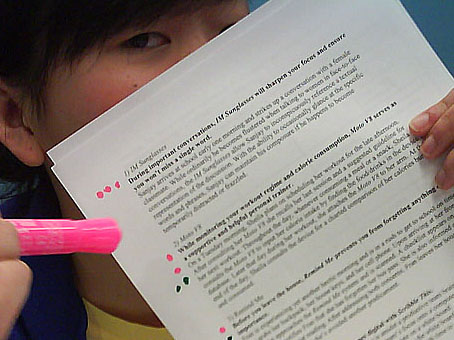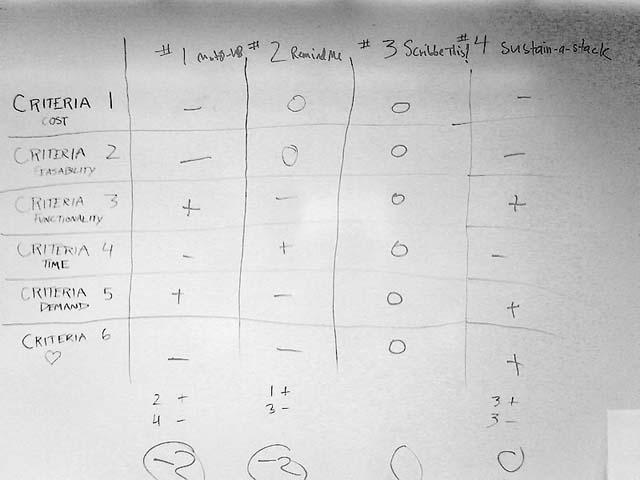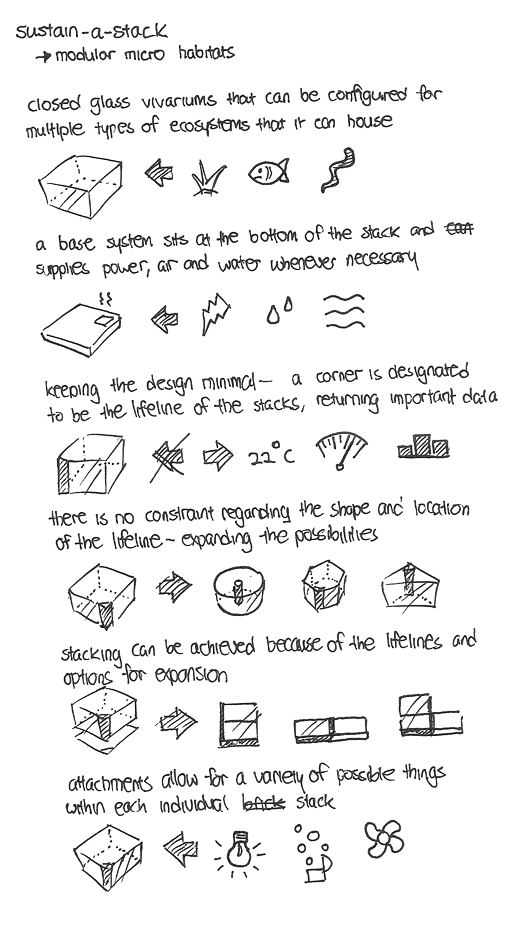05
Fall
2007
Week 3: Project Selection
Posted on: Wednesday, September 26, 2007
We began this assignment by using a voting method, which consisted of each team member using colored dots as an indication of their impressions of each project idea (pink dots indicated a negative impression, while green ones signaled that of a positive association). Further, each member was permitted to use two dots for each idea. This was an effective process as it allowed each member to voice support and concerns. Lastly, we critiqued the ideas by encouraging each member share his/her own opinion — this allowed each member to voice specific issues.
The results (as seen in the photo below) indicated unanimous support for the “Scribble This,” a positive majority for “Remind Me,” and the collective rejection of “IM Sunglasses.”
Below is a tally for each idea:
| Positive |
Negative |
|
|
“IM Sunglasses” |
— |
|
| “Remind Me” |
+++ |
- |
|
“MotoV8″ |
++ |
– |
|
“Scribble This” |
++++++ |
|
|
“MoSo” |
+ |
- |

We then continued our process by utilizing the SCAMPER method. With this method, we attempted to modify and improve our current ideas. Along the way, we were also encouraged to pursue new tangents that might culminate in an entirely new concept. Although we attempted to brainstorm other potential features for each of our ideas, we found that only two of the new features would serve as a possible improvement. Further, we found that we spent the majority of our effort attempting to rework and improve our the team’s most feasible idea, Scribble This.
The proposed improvements that were created during the brainstorm include:
* Remind Me - Aside from providing the user a reminder of forgotten items, this product will also provide a weather update. We felt that this would be a great addition in light of Vancouver’s unpredictable weather and the frequent inability to judge how warm/cold it is outside without stepping outside one’s home. Recommendations for such things as sunscreen or an umbrella could be a great asset.
* Scribble This - In addition to allowing the user to save information from the whiteboard onto a USB drive, this product also:
1. allows the user to upload information or previous “scribbles” on the whiteboard from the computer.
2. utilizes transformative programming that can handle non-text “scribbles” and convert them to vector images.
3. offer a laser optical mouse, which can be used to draw on the whiteboard.
After noting the suggestions, we reevaluated our ideas and narrowed down our choices to a list of three: Scribble This, Remind Me and Moto V8. However, as the group consensus indicated a general dissatisfaction with our ideas in general, we attempted something new and radically different from what we had previously developed. The result of this brainstorm was an entirely original and universally liked idea — “Sustain-a-Stack!”
Although a detailed and descriptive diagram of “Sustain-a-Stack” can be seen below, it would be logical to outline a brief overview of the product. As implied by the title, “Sustain-a-Stack” is a self-sustainable series of stackable “systems” that may consist of aquariums, small single plant based gardens, and/or terrariums. The central idea behind the project being the conservation of space through chic nature-based furniture. One can configure the blocks in any desired form. There were also discussions regarding possible additions that might include a table-based center, on which one could work/read/create.
The selection criteria that our team developed consists of the following:
- Cost — As noted in the initial project description, there is an imposed price limit. Secondly, we’re students and very few of us have cash to throw around.
- Skill sets — In discussing this criterion as a group, it was decided that we’d like to work with specific skill sets that motivate us to create polished products (for our team, this skill is the construction/building of prototypes).
- Research/Time — Although this class does cover eight months, we don’t have an open-ended schedule that permits weeks and weeks of in-depth research.
- Customer Needs — Given that we’d like to create a product that has appeal — at least to a specific group — it is essential to consider the current market.
- Functionality — It is important to consider the actual interaction with the chosen product. Will the product’s functionality enhance some form of interaction?
- Feasibility — This is a tremendously important factor — can we create a product that will work as we intend it to?
- The Fun Factor — Most importantly, will we enjoy working on this project?
| Moto V8 |
Remind Me |
Scribble This |
Sustain-a-Stack |
|
| Time Required? |
More |
Less |
Medium |
More |
| Skills Involved? |
-Database |
-Interaction |
-Programming |
-Construction |
| Background Research? |
Kinesiology |
RFID Sensors |
-Touch Detection |
-Wattage -Self-contained ecosystems -Water pressure -Plant growth |
| Customer Needs? |
-Weight loss -Exercise efficiency |
-Reminder |
-Link between print and technology -Idea storage system -Visual aid |
-Sustainability -Urban Nature -Hobby |
| Our Interest? |
Motivational |
Enhances Memory |
Quick information transfer |
-Eco-friendly |
Judging by the above checklist, there is certainly a positive slant towards the “Sustain-a-Stack” largely because of team’s interest in the project content; although, obviously with such a project there are downsides (it would require considerable time investment, research, and testing). Perhaps the next most promising idea is “Scribble This” because it appears to have a direct correlation to our skillsets (minus construction) and the product itself is something students would be interested in. Unfortunately, both “MotoV8″ and “Remind Me” appear to be write-offs — both have considerable downsides, which include too much/too little time investment and research requirements outside our scope of interest.A ranking list might look something like this:
I.) “Sustain-a-Stack”
II.) “Scribble This”
III.) “MotoV8″/”Remind Me”

As seen in the above decision-making matrix, there is an obvious preference for “Sustain-a-Stack.” Notice that we eventually used “Scribble This” as a neutral project off which we could assess our other ideas (since it appeared to be the most feasible project given our skillsets and project demands, in spite our mixed interests in persuing such an idea). Not suprisingly, “Sustain-a-Stack” championed the demand, functionality, and fun criterions, while scoring noticeably low on cost and feasability. While, inevitably, such a project is bound to have a considerable financial investment, it’s obvious that our team is willing to incur such a hit to work on something we’ll derive satisfaction from. In retrospect, “Sustain-a-Stack” may likely score neutral or positive in terms of the feasability criterion. Again, the evaluation of both “MotoV8″ and “Remind Me” convey our general distaste for each idea; although, it should be noted that we attempted unbiased assessments.We made a unanimous decision to follow through with the “Sustain-a-Stack” product idea. The team believes in the concept of sustainability and creating an eco-friendly project.
In general, the most difficult stage of the decision-making process was our collective dissatisfaction with the ideas we developed in week two. To clarify, we hardly think we developed weak ideas; instead, it became obvious that we spent too much time attempting to solve specific everyday problems and less time brainstorming our interests. As a team, we intend on striving to create a product that excites us. To arrive at an idea such as “Sustain-a-Stack” is a great breakthrough, but the product is without its issues either. Brainstorming and reevaluation will be a constant, everchanging process for our team.
Do the results make sense?
The decision-matrix method resulted in a tie between “Scribble This” and “Sustain-a-Stack,” which is somewhat disconcerning. However, when weighing out the advantages and disadvantages with each specific criteria used in comparing the top four, it can be said that our criteria were well-selected. If anything, the results encouraged us to assess the weakness of “Sustain-a-Stack.”
Does the team feel comfortable with the results?Yes, given our original dissatisfaction with our ideas, the results have been comparably pleasing; although, we realize there is much more assessment needed in the future.
If you did it again, would it come out differently?
After class, the team met to more accurately define the Sustain-a-Stack and a respective functionality set. We further discussed the type of research, materials and tasks we require to make this concept feasible. This re-evaluation of the team’s new idea would, in effect, change the results of the decision-making matrix (as we had more time to expand on the “Sustain-a-Stack” idea). Effectively, the “Sustain-a-Stack” would score a higher rating.
Do you need more information to do it properly?
These decisions were made with thoughtful consideration, but more background research on each of the ideas would certainly result in a more accurate and un-biased decision-matrix.
